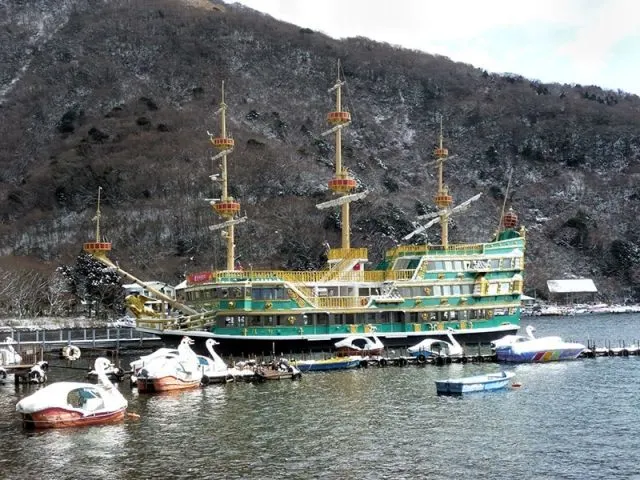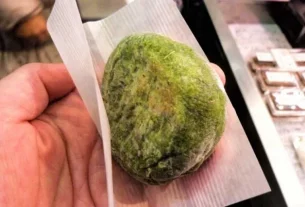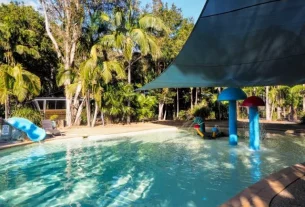Hakone is a popular day trip from Tokyo or an interesting short-stay option. For visitors who want an onsen experience while in Japan but don’t have the time to travel further afield, it’s easily accessible in Hakone and there’s so much more to see and do in the area.

In an earlier post, we looked at a day trip itinerary for Hakone out of Tokyo taking in several of the highlights including the gorgeous views, cable cars, ropeways, the geothermal area at Owakudani, a cruise on the beautiful Lake Ashi and some glimpses into the history of the area dating back to the Edo period.
I recently reviewed the value we received from the Osaka Amazing pass and based on feedback from that one I thought it would be helpful to take a closer look at some of the other passes we’ve used during our travels in Japan. We don’t regularly buy city passes, often they’re not suited to our slower pace or the way we travel. We like to throw in detours as we go and adjust plans when something takes our interest along the way. We’re also quite selective about what we want to see and do with our limited time, we won’t go to something just because it’s a free inclusion on a pass.
Table of Contents
An Overview of the Hakone FreePass
The Hakone Free Pass includes all Odakyu-affiliated transport within the Hakone region. It covers 8 forms of transport including trains, buses, cable cars, cableways and a boat that is sufficient to get you around all the major sights of the region including the Gotemba Outlet Mall.
You also get discounts on a number of attractions including museums, gardens, hot springs, shopping and dining establishments. A few attractions such as the Gora Park Botanic Gardens have free entry with the pass. Just watch for the stickers on the doors or booking windows to show whether they participate if you aren’t sure.
There are a variety of pass options available. These include
- a 2 or 3-day pass (we found the 2-day option can also be cost-effective for a day trip)
- return transport from Shinjuku in Tokyo or only within the Hakone region, and
- there are adult and child passes available
If you are already in Hakone, have an active JR Pass, or find it more convenient and cost-effective to travel direct from another city or part of Tokyo you might choose as we did to purchase the Hakone-only pass.
If you choose the ticket including the Shinjuku return version you need to be aware that this now includes either the Hakone Highway Bus which takes around 2.5 hours or the normal fare portion of the Romance-car limited express train from Shinjuku. If you select this option you will also pay a surcharge (currently Y890) which is the Limited Express Surcharge and a seat fee for the train which reduces the trip down to around 85 minutes.
The ticket prices are:
Inside the Hakone Area: Y4000 for the 2-day pass, Y4,500 for the 3-day pass
From Shinjuku in Tokyo: Y5,140 for the 2-day pass, Y5,640 for the 3-day pass
You can view more information on the discounted attractions at the Hakone FreePass Official site.
Tickets can be purchased from ticket machines or counters at Shinjuku station or arrival stations such as Odawara, the Shinkansen station in the Hakone area. A new option is that you can now purchase the pass online before you travel.
The transport within the Hakone region covered by the FreePass can all be used as many times as you want within the period covered by the pass. While most people complete the course as a loop you can change direction and repeat sections if you want to within the same day or on consecutive days. This might be useful if you want to complete the course and go back to a section if you have time at the end of the day, or where you are using it across multiple days.
How we used the Hakone FreePass
Which Pass
Although we were only taking a day trip we purchased the minimum 2-day pass at Odawara Station for Y4,000 (around A$45). The reason we started at Odawara, not Tokyo was that we already had an active JR Pass covering the period. The JR pass lets you use the Shinkansen at no incremental cost, so it’s both faster and offered more choices on when we started and ended our day. The Shinkansen takes 35 minutes from Tokyo station, and the Odakyu Romance car takes 85 minutes from Shinjuku station which was further away from where we were staying.
Odawara to Gora
This leg takes about an hour to travel on the Hakone Tozan Railway. You catch the Tozan train from the same Odawara station building that you arrive in on your trip from Tokyo.
We sat on the left-hand side of the train and got some amazing views out of the big picture windows. During winter the mountain was covered in pure white powder snow, other seasons would be equally pretty though and we’re considering returning with a different itinerary for an autumn foliage visit.
If you want to go to the Hakone Open-Air Museum get off at Chokoku no Mori station (one stop before Gora) and it’s an easy walk from there.
The cost without the Hakone FreePass would be Y670.

Gora to Sounzan
It’s a very short walk from the Gora Tozan train station to the cable car station. If you were going to walk from there it’s a very steep slope, especially in the winter’s snow but the cable car makes the 1.2km track a breeze in around 10 minutes. Make sure you position yourself to enjoy the view, it’s beautiful.
The cable car takes you to the boarding area for the first section of the ropeway.
The cost without the Hakone FreePass would be Y420
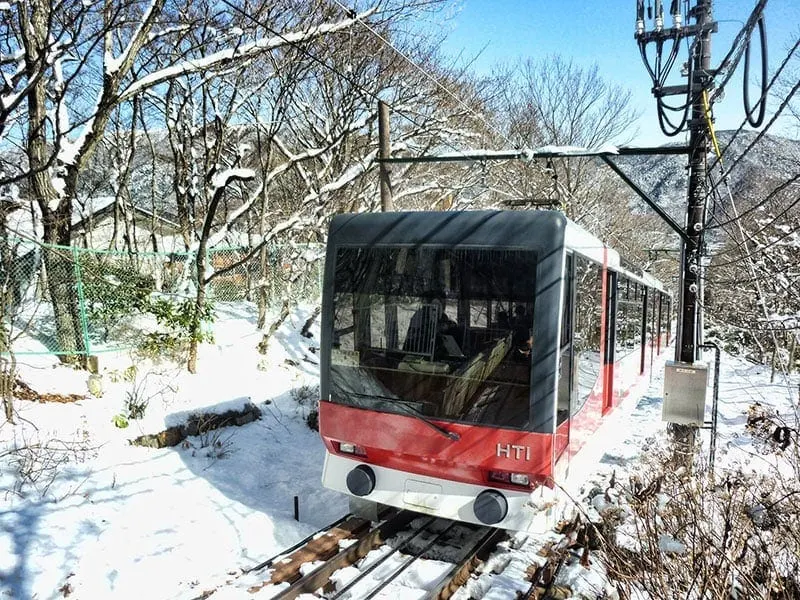
The Rope-way
There are 3 sections on the ropeway so it is a decent length ride to take a good look at the natural area and geothermal landscapes around and under you. The first section is Sounsan to Owakudani, then Owakudani to Ubako and finally Ubako to Togendai station.
Take some time at Owakudani to have a good look around. The views of Mt Fuji if you have a clear day are absolutely stunning from here. If you walk up to the geothermal area you can see where they cook the black eggs. There are large steaming vents in the mountain and pools of almost boiling water. There’s a restaurant for lunch at the top and you can buy the black eggs said to give 7 years of good luck.
The cost without the Hakone FreePass would be Y1370
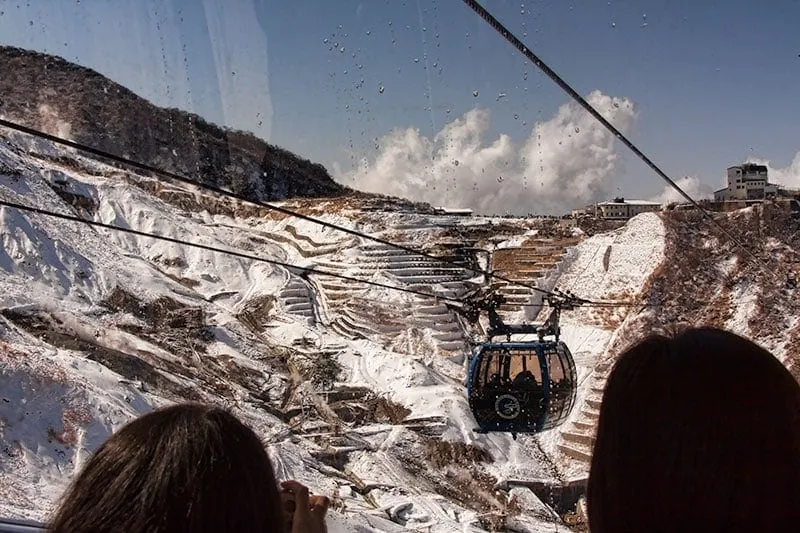
Hakone sightseeing cruise
From the last ropeway station at Togendai walk down to the edge of the lake. We spent a while walking around a park area on the edge of the lake waiting for the next sailing time. We weren’t sure about the relevance of the pirate ship on the lake but then the 1970s swan paddle boats were a bit of a mystery too. The views from out on the lake were excellent, you could see Mt Fuji and the Hakone Shrines floating torii towards the other end of the crossing.
During winter the hillside was quite bare and brown, at other times of the year you would expect to see it covered in blossom, coloured autumn leaves or greenery.
The cost without the Hakone FreePass would be Y1000
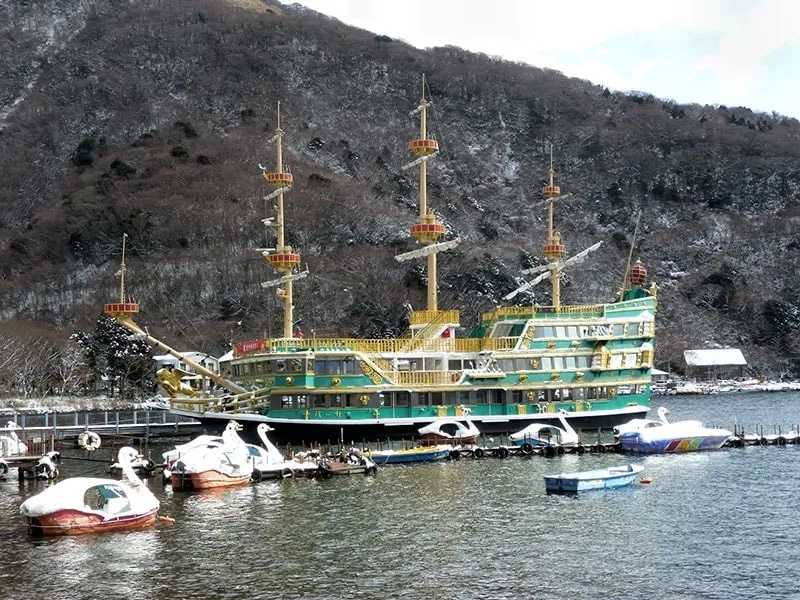
Hakone Tozan bus
We only used the bus to get back from Lake Ashi to Odawara station but there’s an extensive bus network if you’re staying in the area or want to visit attractions further out.
The bus isn’t our preferred transport in Japan, the seats are quite small, you board at the back door and they run on time so there is little patience if you’re a bit slow finding the right money. Another reason why I like to have either a day pass or a stored value card for the transport.
The cost without the Hakone FreePass for this ride would be Y960
Is the Hakone FreePass good value?
The FreePass included value for the route we took is Y4420 for a purchase price of Y4000. We did the course we planned to do and saved Y420 or 9.5%.
So we did find the pass worthwhile? While the financial saving was minimal for a day trip it was very easy to purchase the Freepass at Odawara station and it meant we didn’t need to queue for tickets or find the right change throughout the day. If collecting a pass from the Odawara Station Information Centre isn’t convenient there are also dispensing ticket machines at Odakyu stations along the line.
In hindsight, we didn’t feel the pass was a necessity for the day trip but there was no downside, it was convenient and offered a small cost saving. The cost-saving would be better for anyone either using the full round trip from Tokyo or staying in Hakone overnight and continuing their sightseeing on the second day.
Interested? You can save these images to Pinterest for later
If you want to know more about what there is to see and do in Hakone, or if you’re interested in some additional information and tips for planning your trip you may also want to read our article on A Day Trip to Hakone.
If you’ve visited Hakone either using the free-pass or without, we’d love to hear your thoughts in the comments below.
